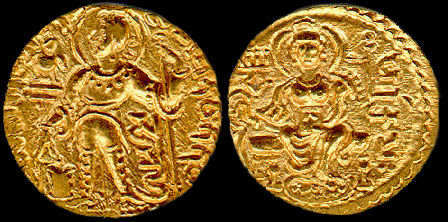

Coins are reflections of history! The study of coins, also called numismatics , has been crucial in deciphering history. The study of ancient and medieval coinage have authenticated historical events known from literature, artifacts and archaeological findings. Indeed, the history of the Indian subcontinent and it's coinage share the complexities as evident in presence of hundreds of dynasties and their attempt to issue distinct coinage over thousands of years. Paradoxically this very facet made the study of Indian history and numismatics an interesting but challenging proposition. Modern research in numismatics led to discoveries which firmly established existence of numerous rulers (and on many occasions entire dynasty!), as no trace of their presence can be found today. We learned a lot about the early dynasties of Indian subcontinent mostly because of meticulous and systematic numismatic research done in last couple of centuries. Indeed, Kharoshthi and Brahmi, the ancient scripts of India are deciphered from bilingual coins of Indo-Greek and Kushan rulers. Essentially, it was the deciphering of Kharoshthi and Brahmi (by James Princep) which allowed historians to read the ancient rock and other inscriptions and thus whole history of ancient India was unfolded. Further, the evolution of the designs, the changes in the languages, scripts and dates shown on the coins, enabled scholars to establish the sequence of rise and fall of kingdoms and their rulers. The provenance of the coin hoards also helped to determine the region occupied and governed by the numerous emperors and kings over last three millenniums.
India, which historically includes Pakistan, Bangladesh, Nepal and Afghanistan, is also known as Bharat Varsha, a land of famous King Bharata or Hindustan. The name `India' was applied to this country by Greeks. Aryans, the early inhabitants of the subcontinent were mystified by the mighty river which they named Sindhu (in Sanskrit, it means `like an ocean'). The river Sindhu or Sindh was called Indus by Greeks and thus the country was called India. The size of the Indian subcontinent is enormous which is almost as large as Europe without Russia or twenty times bigger than Great Britain. In ancient Sanskrit text Vishnu Purana, it is written that all the descendents of Bharata (people of India) have been given the land of thousand Yojanas (leagues) which stretch from snowy mountains of Himalayas in the north to Adam's bridge in the south, and from the valley of Bramhaputra river in the east to the land beyond seven mouths of Indus in west.
This webpage contains many interesting coins. It has one of the first coins of Indian subcontinent, minted 2600 years ago! You would see the gold coins of Kushana Dynasty and Gupta dynasty which are considered to be one of the finest gold coins of ancient world. I have also included the first Rupee , the silver coin introduced by Sher Shah Suri. You will also find gold and silver coins of most of the Mughal emperors, coins of Chatrapati Shivaji , Maratha Independent rulers, gold and set of the silver coins minted during British Raj and some rare and unique coins. The coins shown are from personal collection so DO check with me if you wish to use the images. You are NOT allowed to reproduce these images for any publication or website design, without my prior permission. If required, I might be able to provide high resolution slides or pictures or scans of most of the Indian coins (majority of which are not shown on website). On this webpage, I have maginified most coins twice the actual size (2X) to veiw the finer details more clearly.
This page is constantly under construction and I would be glad to incorporate your suggestions and answer any questions that you may have. Please contact me for all the additional information that you may like to know about YOUR collection of coins and to enhance it. If you wish to become a serious numismatist, you are welcome to contact me for any help tht you may need. I shall be glad to answer any questions in that regard. The reason Why A Webpage For Indian Coins? would become clear as you proceed.
This page is divided into following sections: